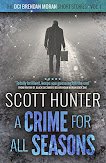Born and raised initially near Cork and later in Co. Kerry after his parents moved away during his teens, Moran was left in the care of the Hannigan family where he met and fell in love with Janice, the Hannigans’ eldest daughter.
They were engaged to be married, but Janice was tragically killed in a car bomb incident in the late 1970’s. The bomb had been meant for Moran ... he has never forgiven himself for Janice’ death, nor has he been able to settle into a relationship since.
Moving to England in the early nineteen-eighties, he joined the Thames Valley Police and rose through the ranks on merit. He has experienced various setbacks in his career .... he was almost killed in a car accident .... and also injured during the course of an investigation .... also has an acute knack of being able to figure people out.
Black December
DCI Brendan Moran, world-weary veteran of 1970s Ireland, is recuperating from a near fatal car crash when a murder is reported at Charnford Abbey.
The abbot and his monks are strangely uncooperative, but when a visitor from the Vatican arrives and an ancient relic goes missing the truth behind Charnford's pact of silence threatens to expose not only the abbey's haunted secrets but also the spirits of Moran's own troubled past . . .
Creatures of Dust
An unusual crime requires an unusual detective ... An undercover officer goes missing and the body of a young man is found mutilated in a shop doorway. Is there a connection? Returning to work after a short convalescence, DCI Brendan Moran's suspicions are aroused when a senior officer insists on freezing Moran out and handling the investigation himself.
A second murder convinces Moran that a serial killer is on the loose but with only a few days to prove his point the disgruntled DCI can't afford to waste time.
As temperatures hit the high twenties, tempers fray, and the investigation founders Moran finds himself coming back to the same question again and again: can he still trust his own judgement, or is he leading his team up a blind alley?
Death Walks Behind You
DCI Brendan Moran's last minute break in the West Country proves anything but restful as he becomes embroiled in the mysterious disappearance of an American tourist.
Does the village harbour some dark and dreadful secret? The brooding presence of the old manor house and the dysfunctional de Courcy family may hold the answer but Moran soon finds that the residents of Cernham have a rather unorthodox approach to the problem of dealing with outsiders.
As Moran is drawn deeper into Cernham's mysterious past a cold-blooded execution in Berkshire plunges deputising DI Charlie Pepper into a maelstrom of murder, double cross and treachery ...
From the midwinter snowdrifts of an ancient Roman villa to a summer stakeout at an exclusive art gallery, join DCI Brendan Moran and his team for the first volume of criminally cunning short stories in which the world-weary yet engaging Irish detective reaffirms that there is indeed a crime for all seasons . . .
Silent as the Dead
A call from an old friend whose wife has vanished from their home in Co.Kerry prompts DCI Brendan Moran to return to his Irish roots. The Gardai have drawn a blank; can Moran succeed where they have failed?
Moran's investigation leads him to a loner known locally as the Islander, who reveals that the woman's disappearance is connected to a diehard paramilitary with plans to hit a high profile target in the UK.
Time is running out. Can Moran enlist the Islander's help, or does he have to face his deadliest foe alone?
Gone Too Soon
Moran is called to a burial in a local cemetery. But this is no ordinary interment; the body of a young woman, Michelle LaCroix, a rising star in the music world, is still warm, the grave unmarked. A recording reveals the reason for her suicide. Or does it?
Why would a young, successful singer take her own life? To unlock the answer, Moran must steer a course through his darkest investigation yet, as the clues lead to one shocking discovery after another . . .
The Enemy Inside
Whoever said 'Keep your friends close and your enemies closer' was right. But maybe not this close ...
DCI Brendan Moran's morning is interrupted when a suicidal ex-soldier threatens to jump from a multi-storey car park ...
Moran soon regrets getting involved when an unexpected visitor turns up on his doorstep to confront him with what appears to be damning evidence of past misconduct.
Can the Irish Detective clear his name, or must he come clean and face the consequences? One thing seems certain: by the time the night is over, his reputation may not be the only casualty ...
When Stars Grow Dark
A fatal road traffic collision uncovers a bizarre murder when it transpires that an elderly passenger in one of the vehicles was dead before the accident. All indications point to the work of a serial killer - but with little forensic evidence, how can DCI Brendan Moran and his team run the killer to ground?
To add to Moran's problems, an unexpected discovery prompts the Irish Detective to undertake a dangerous and unscheduled journey to Rotterdam where he believes his former friend and MI5 agent, Samantha Grant, is being held. Can Moran succeed in his rescue mission whilst juggling the heavy demands of his most perplexing murder investigation to date?

























